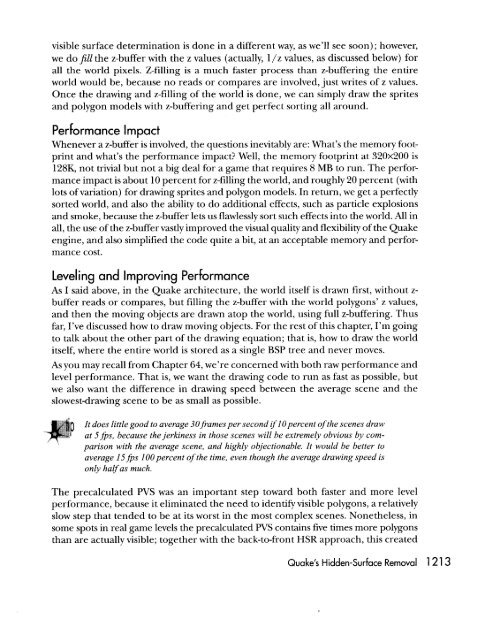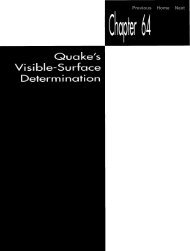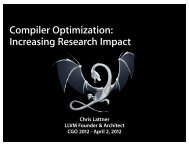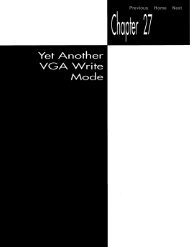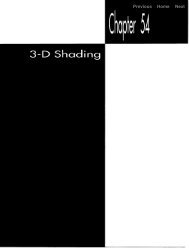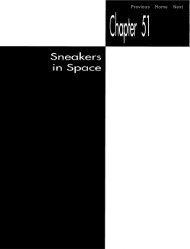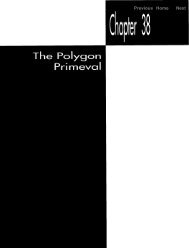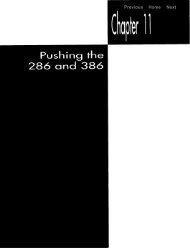Create successful ePaper yourself
Turn your PDF publications into a flip-book with our unique Google optimized e-Paper software.
visible <strong>surface</strong> determination is done in a different way, as we’ll see soon) ; however,<br />
we do fill the z-buffer with the z values (actually, l/z values, as discussed below) for<br />
all the world pixels. Z-filling is a much faster process than z-buffering the entire<br />
world would be, because no reads or compares are involved, just writes of z values.<br />
Once the drawing and z-filling of the world is done, we can simply draw the sprites<br />
and polygon models with z-buffering and get perfect sorting all around.<br />
Performance Impact<br />
Whenever a z-buffer is involved, the questions inevitably are: What’s the memory footprint<br />
and what’s the performance impact? Well, the memory footprint at 320x200 is<br />
128K, not trivial but not a big deal for a game that requires 8 MB to run. The performance<br />
impact is about 10 percent for z-filling the world, and roughly 20 percent (with<br />
lots of variation) for drawing sprites and polygon models. In return, we get a perfectly<br />
sorted world, and also the ability to do additional effects, such as particle explosions<br />
and smoke, because the z-buffer lets us flawlessly sort such effects into the world. All in<br />
all, the use of the z-buffer vastly improved the visual quality and flexibility of the Quake<br />
engine, and also simplified the code quite a bit, at an acceptable memory and performance<br />
cost.<br />
Leveling and Improving Performance<br />
As I said above, in the Quake architecture, the world itself is drawn first, without z-<br />
buffer reads or compares, but filling the z-buffer with the world polygons’ z values,<br />
and then the moving objects are drawn atop the world, using full z-buffering. Thus<br />
far, I’ve discussed how to draw moving objects. the For rest of this chapter, I’m going<br />
to talk about the other part of the drawing equation; that is, how to draw the world<br />
itself, where the entire world is stored as a single BSP tree and never moves.<br />
As you may recall from Chapter 64, we’re concerned with both raw performance and<br />
level performance. That is, we want the drawing code to run as fast as possible, but<br />
we also want the difference in drawing speed between the average scene and the<br />
slowest-drawing scene to be as small as possible.<br />
p<br />
It does little good to average 30 frames per second if1 Opercent of the scenes draw<br />
at 5 fps, because the jerkiness in those scenes will be extremely obvious by comparison<br />
with the average scene, and highly objectionable. It would be better to<br />
average I5 fps 100percent of the time, even though the average drawing speed is<br />
only halfas much.<br />
The precalculated PVS was an important step toward both faster and more level<br />
performance, because it eliminated the need to identify visible polygons, a relatively<br />
slow step that tended to be at its worst in the most complex scenes. Nonetheless, in<br />
some spots in real game levels the precalculated PVS contains five times more polygons<br />
than are actually visible; together with the back-to-front HSR approach, this created<br />
Quake’s Hidden-Surface Removal 1213


